Linux powers $199 thin client dev kit
Oct 6, 2004 — by LinuxDevices Staff — from the LinuxDevices Archive — 25 views PMC-Sierra has developed a 400MHz MIPS architecture system-on-chip (SoC) processor for embedded designs that draws less than 1 watt (claimed, typical). The RM5231A SoC is available now in a choice of two $199 development kits, which implement ready-to-run Linux-based hardware/software thin-client reference designs,… the company says.
PMC-Sierra has developed a 400MHz MIPS architecture system-on-chip (SoC) processor for embedded designs that draws less than 1 watt (claimed, typical). The RM5231A SoC is available now in a choice of two $199 development kits, which implement ready-to-run Linux-based hardware/software thin-client reference designs,… the company says.
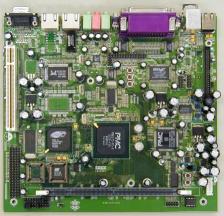

The $199 Fujian START and PMC-Sierra reference design SBCs (single board computers)
(Click either board to enlarge)
“Xiao Hu” (pronounced “Sha hu”) means “little tiger,” according to PMC. The low-cost platform was conceived by China's Tsinghua University, and implemented by PMC in partnership with MIPS Technologies (the licensor of the MIPS processor archicture) along with graphics chipmaker ATI. It supports Red Hat, MontaVista, and Red Flag Linux, and targets classrooms, Internet cafes, smart terminals, POS (point-of-service), kiosks, cameras, and robotics. Additionally, it can serve as a general purpose embedded Linux reference design for many other applications.
Bringing computing to the masses
Among other possibilities, PMC hopes its Xiao Hu reference platform will help bring thin client based desktop computing to developing nations where the typical 66 watt energy cost and high capital expenses of conventional PCs are prohibitive. For example, China's goal of providing a computer to each of its 200 million students would consume 30 percent of the electrical output of the Three Gorges Dam with traditional PCs, according to PMC CEO Bob Bailey, compared to 1 percent for Xiao Hu thin client terminals based on the RM5231A processor. Bailey adds that the PMC Xiao Hu thin client can save more than 50 percent of the capital cost in comparison with even low-cost PCs, estimating that the cost of the Xiao Xu clients will be under $150 (USD) in volume in comparison with $299 (USD) for the “lowest cost PCs.”
Professor Dongsheng Wang, director of the Microprocessor and SoC Technology Center at Tsinghua University said, “Networked computing shall have huge market potential as end-users gain deeper understanding of the networked computing models and consumption habits grow more sensible.”
About the RM5231A MIPS processor
The heart of the Xiao Hu platform is a 64-bit MIPS RM5231A processor that dissipates just 1 watt (typical), while taking up just 4.8 square centimeters, PMC claims. In other words, the chip uses about 8 percent as much power as a Via C3, while taking up 60 percent less area. The Xiao Hu development boards do not provide even a heat sink — much less a fan — for the chip.
The chip features a dual-issue 64-bit superscalar architecture with a 64-bit integer unit and a pipelined 64-bit FPU (floating point unit). It has 32KB each of 2-way set associative data and instruction cache. The external bus width is 32-bits, and it is available in a 128-pin QFP or ExposedPad package. A sibling part with a 64-bit external bus width, the RM5261A, is available in a 208-QFP or 216-ExposedPad package.
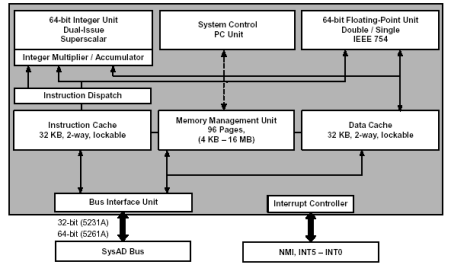
RM5231A block diagram
(Click to enlarge)
What's in the Xiao Hu development kit?
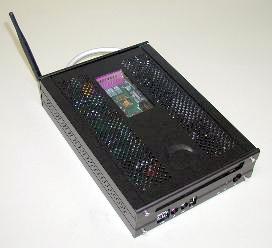 PMC's low-cost Xiao Hu development kit includes:
PMC's low-cost Xiao Hu development kit includes:
- Fully tested and ready-to-use “network computing system,” including a compact enclosure, power supply, SBC (one of the two reference design SBCs pictured above), and internal cabling
- Hardware reference design including schematics and PCB (printed circuit board) layout
- Software reference design with build instructions for a boot loader, Linux kernel, and thin client protocol applications (with source code either included, or availab le for download)
Further hardware and software specs are given below.
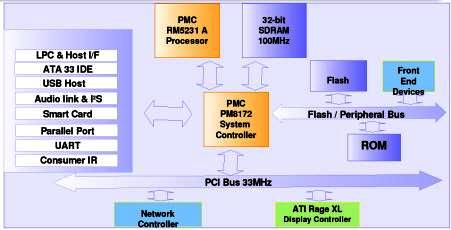
Functional diagram of the Xiao Hu hardware platform
Xiao Hu hardware features
PMC lists the hardware features of the Xiao Hu reference design SBC as follows:
- RM5231A 64-bit MIPS process clocked at 400 MHz
- Pin-compatible upgrades: the 600MHz RM7035C and 900 MHz RM7935
- 128MB of SDRAM (4M x 16 bit x 4 banks x 4 chips)
- Up to 4Mbit (512K x 8) of boot Flash ROM in 32 pin PLCC, socketed. 90ns. Using 3V parts
- Supports IDE flash module
- PM8172 system controller is an Ultra RISC companion chip in a 400-pin BGA package. It provides DMA controllers, counter/timers, and RTC (real-time clock)
- ATi RAGE XL graphics controller (3.3V and 2.5V, 272 pin PBGA)
- Standard connectors for:
- VGA monitor
- 10/100 Base-T Ethernet
- PCI Rev. 2.2 local bus
- UART
- Two wire serial bus controller, 100k or 400k bps
- Smart card interface
- Consumer IR interface – CIR0, CIR1
- ATA 33 IDE interface
- Audio (AC97), stereo out, line in
- Two USB 1.1
- Parallel port
- GPIO (general purpose I/O)
- PS/2 mouse and keyboard
- IDE
- Flex-ATX form factor (9 x 7.5 inches)
- ATX power supply connector
Xiao Hu software features
PMC lists software features of the Xiau Hu development kit as follows:
- X11, RDP, and VNC protocols
- Easy administration and management of server-based software
- Built using open-source components with no licensing fees:
- MIPS-Linux kernel version 2.4.25 with glibc-2.3.2
- Busybox embedded Linux utilites version 1.00
- XFree86 graphical display server version 4.4.0
- Rdesktop RDP protocol client version 1.3.1
- RealVNC protocol client version 3.3.7
- WinCE software kernel available upon request
- Built using industry-standard GNU MIPS cross-toolchain on x86/RedHat Linux 9 platform
- Software package includes a script for building all components, including the cross-compiler
- Requires DHCP server, NFS server, and X11 font server, commonly distributed on Linux installation disks
More highly integrated SoC coming soon
PMC plans a successor to the RM5231A, codenamed “GP,” that will save more power by integrating system components such as the memory, PCI bus interface, dual USB 2.0 interfaces, and dual Ethernet MACs. The result will be lower cost, fewer components, and reduced board space requirements, PMC says. The chip will target a broad spectrum of general purpose embedded system and device applications, including the same ones targeted by the Xiao Hu reference kit. Availability of the GP, which will be software-compatible with the current Xiao Hu Development Kit design, is planned for Q2 of 2005.
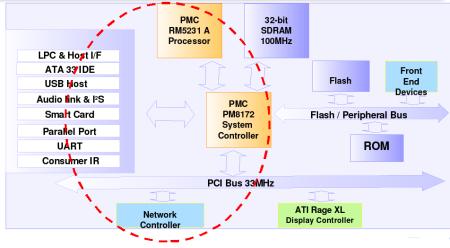
PMC's “GP” SoC will feature higher integration
Development kit availability
Orders are now being accepted for the PMC Xiao Hu Development Kit, offered in a choice of two models, for $199 each. Further details are available online.
This article was originally published on LinuxDevices.com and has been donated to the open source community by QuinStreet Inc. Please visit LinuxToday.com for up-to-date news and articles about Linux and open source.